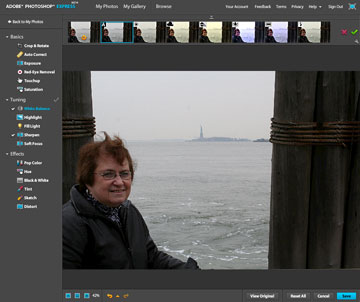Adobe has brought its expertise in digital image editing to “the cloud”. It now offers a browser-based application – Photoshop Express. The service not only provides powerful image editing capabilities, but also the opportunity to store up to 2 GB worth of images. This screen shot may give you some feel for the tools – left column.

I have read concerns in another blog related to the user agreement.
Sharing Your Photos
As part of registering for the Service and creating an account, Adobe may require you to create a user name (“User Name”) and user-specific URL, such as xxx.photoshop.com (“Personal URL”). The Service allows you to share Your Content that you upload to your account in the following ways: (a) by using the “Gallery” function to publicly share Your Content on the “Gallery” site of the Service, (b) by using the “email” function to send an email containing a URL link to Your Content, and (c) by using the “Link” function and the “Embed” function to include a link or embed Your Content on a web page. Please note that when you share Your Content, your User Name and Personal URL is made public, and recipients may in the future be able to share Your Content with others, add Your Content to their own accounts, and make photographic prints of Your Content. Adobe may revoke the right to use that URL for any reason deemed appropriate by Adobe in its sole discretion by giving you at least thirty days’ prior notice of such revocation, except in the event your URL or content therein is determined by Adobe in its sole discretion to contain infringing or illegal content or content that otherwise violates these Additional Terms or the General Terms. In such event, Adobe reserves the right to revoke the right to use your URL immediately without notice. Adobe owns and retains all right, title and interest in the use of “Adobe,” “Photoshop,” “Photoshop Express” or other Adobe property in association with a user’s Personal URL.
I have been trying to decide if any of this agreement bothers me. I think Adobe is just warning me that they are not responsible for how others may use my images. I would use this service for images I wanted to make public in much the same way I make images available on Flickr. I understand that I must accept the possibility that my online storage opportunity may be terminated, but I should have 30 days to deal with this situation if I must. Nothing here that seems too negative. I doubt my images have commercial value and I typically am trying to offer my images to others who may find some educational value in a few of my pictures.
As suggested in the user agreement, some images are available at http://grabe.photoshop.com.
24 total views


